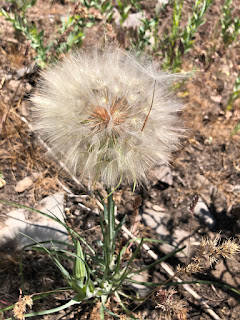 |
| Tragopogon dubium |
 |
| the most recognizable but least edible stage |
The whole plant is more-or-less edible, but the best and easiest part to eat, in my experience, is the flower and the stalk immediately below the flower. But you have to pick the flower at the right time, before it goes to seed when it is still tender. The flower has an interesting life cycle where it forms a bud, then opens, usually in the morning for a day or so. It then closes again, and opens again when the seeds are ready into the distinctive "giant dandelion" form. The flowers are easiest to find in the morning, when they will be first opening in sunny grassy fields. I have walked through a field in the morning and seen many open flowers, then walked through the same field in the afternoon and seen none. They are good tasting and tender when the flowers are fresh. When they close up again to form seeds they become rather too tough to eat. The flower buds before flowering are also excellent to eat, but you need to distinguish them from the closed flowers which are forming seeds. If you pull the bud open and see bright yellow petals, it is good to eat. If you just see some faded yellow petals near the tip of the bud, then it is older and forming seeds. Whether you eat the flower or bud, be sure to include the stem below the flower, which is especially sweet, and is one of my favorite trail-side snacks.
I have not found roots of Tragopogon dubium which are good to eat. Mainly this is because the plant is a biennial, and it is difficult to identify in the first year when the root is storing up energy. The leaves are long and narrow and grass-like, making them difficult to see in grassy fields where it is likely to grow. In the second year of growth it sends up a flower stalk, and the flowers and seeds are very easy to identify, but by then the root energy has been expended in growing the flower stalk and has become tough and woody. If you have ever let a garden carrot stay in the ground all winter until the next year when it sends up a large flower stalk, you have witnessed a similar biennial growth pattern. The carrot root becomes woody and no longer tastes good after it uses the stored energy to send up the flower stalk. The roots of Tragopogon porrifolius are much larger and more tender, so eat those if you can find them. Unfortunately, that species is rare in my area.
No comments:
Post a Comment